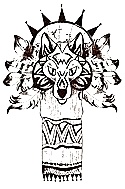AN OVERVIEW.
DEITIES, CULTURE HEROES AND ANCESTORS.
IMAGES AND THE BODY.
NATURE SPIRITS, HUNTING RITUALS, AND VEGETATION RITES.
THE SOUL, THE DEAD AND ANCESTORS.

ENCYCLOPEDIA OF RELIGION
LINDSAY JONES. Macmillan Reference USA
Among the Indians of Tierra del Fuego there is no trace of a cult of the dead to be found in the funerary practices. In this region, socioreligious emphasis was placed on rites that are generally associated with the initiation of members of both sexes and particularly on those rituals connected with the acceptance of young males into men’s organizations (the Kloketen of the Selk’nam and the Kina of the Yahgan). During these rites, a chain of men came out to frighten the women. The participating men wore conical masks made from bark or animal skin that covered their heads and faces. Their bodies were painted black, white, and pink in various patterns. Although they represented specific demons and spirits of the sea, forest, and animals, there was apparently no ghost of the dead among them. The appearance of masks so far south is correctly attributed to the extensive influence of the Tropical Forest cultural areas. Between the Tropical Forest and Tierra del Fuego, there are no gaps in the appearance of masked dances in connection with initiation celebrations, as for example the Anapösö, or Forest Spirit feast, of the Chamacoco. In this region of the Gran Chaco, the performers representing the forest spirits were elaborately decorated with feathers. These spirits are believed to have been ruled by the dog demon Pohitschio, who was the consort of the great mother, Eschetew uarha. Formerly the performers wore artistically intricate feather masks that were later replaced by sacks worn over the head with eyeholes cut in them. In either case, the women were not allowed to discover that these spirits were in reality men from their own tribe. The Lengua of the Gran Chaco use a masked dance to represent symbolically the supernatural danger that threatens women at the onset of menstruation. In this dance, the single men, wearing rhea-feather belts and masks, approach the young women during a typical female puberty celebration. The young women believe them to be the bad spirits. They are eventually driven away by the adult women after they harass and threaten the young girls.
CONCLUSION. Because of the extreme variety of time periods from which information about these tribes is drawn, the only perspective that can be achieved in such an overview is of a diachronic nature. To close this survey of the various forms of religion, I shall briefly indicate phenomena that are particularly characteristic of the individual cultural areas. The central Andes of pre-Columbian times is characterized by a belief in high gods and their respective cults, by the worship of ancestors and of the dead, and by agrarian rites directed to a female earth deity. The peoples of the region of the Amazon and Orinoco rivers occasionally display signs of high-god worship (Witóto, Tupi-Guaraní). Along with the vegetation cults (northwestern Amazon) that are typical of crop-cultivating peoples, there is a markedly large number of ceremonies and rites associated with deities of the hunt and of wild animals (including fish). The Ge of eastern Brazil exhibit clear signs of worship of astral deities - the Sun and Moon. The cults of the dead and of ancestors dominate much of their religious life. The Gran Chaco, by contrast, is noticeably lacking in religious ceremonies and rites in the narrow sense. First-fruit ceremonies related to hunting and fishing predominate; there are no agrarian rites. In the Pampas and Patagonia region a number of socioreligious rites are attested. The Selk’nam and Yahgan of Tierra del Fuego Archipelago believe in a high god, but there is little indication of cult worship. The regions of southern and central Andes share many aspects of religious life. The high-god cult (Ngenechen) is associated with a cultivation and fertility ritual. A highly developed form of shamanism is also prominent. Throughout South America outside the Andean region, the shaman remains the pillar of the religious life.
SEE ALSO
Amazonian Quechua Religions; Ethnoastronomy; Ge Mythology; Inca Religion; Inti; Jaguars; Lord of the Animals; Mapuche Religion; Selk’nam Religion; Shamanism, article on South American Shamanism; South American Indians, articles on Indians of the Andes in the Pre-Inca Period and Indians of the Gran Chaco; Supreme Beings; Tehuelche Religion; Viracocha; Yurupary.
OTTO ZERRIES (1987) Translated from German by John Maressa
















